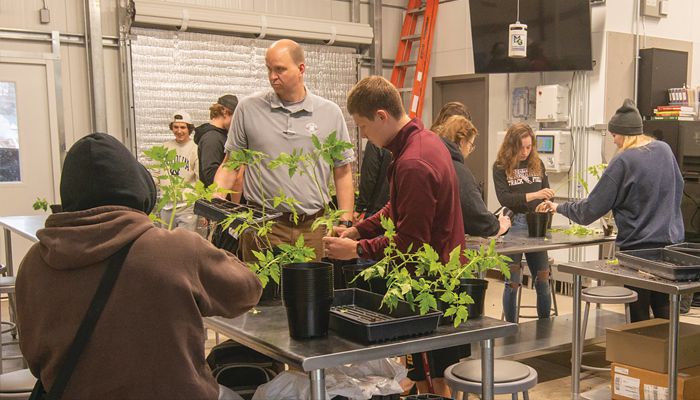Morningside ag program seeing phenomenal growth
Author
Published
4/25/2022
Morningside University continues to invest in its Applied Agriculture and Food Studies Department with the recent purchase of 76 acres of land southeast of Sioux City that will be utilized for hands-on learning by students in its expanding agriculture department.
Morningside purchased two parcels of land, 63 acres and 13 acres at a combined cost of approximately $1.28 million, and will use the farm for student learning experiences including everything from crop scouting and hybrid analysis to agribusiness management, budgeting and potentially fully operating the farm.
Tom Paulsen, associate professor and head of the Regina Roth Applied Agricultural and Food Studies Department, said they are grateful to those who have provided support for the program to grow and flourish.
“The addition of this land will allow our students and faculty to take research and learning they are already doing to a whole new level,” Paulsen said.
“There are all kinds of opportunities to be engaged in experiential learning, and that’s so critical for students as they want to enter the agricultural industry.”
Launched in 2015, the ag department has expanded from a first-year class of eight students to now 75, along with the addition of an on-campus garden, the new Rosen Ag Center and Lags Greenhouse and an ag education program.
Filling a need
Initial discussions between the university and regional ag leaders led to the integration of the ag program at Morningside seven years ago.
“Right now we have such a huge need in the agricultural sector for high quality employees,” Paulsen explained. “We aspire to be a regional resource.”
The school's board of directors understood the importance of agriculture, and administrative and board support is the reason the program initially was developed, he said.
“They all came to the conclusion that we need to have agriculture at Morningside University,” Paulsen said.
For student Thomas Heetland of Hartley, who is studying Applied Agriculture and Food Studies with a minor in agronomy and agribusiness, these program investments are welcome. He enjoys the hands-on learning and smaller class sizes at Morningside that allow for more interaction and personal relationships.
“I am beyond excited with the purchase of the 76 acres that is extremely close to this campus,” Heetland said. “This is a great opportunity to expand our agricultural department and give students even more hands-on experiences surrounding topics such as soil testing, nutrient analysis reports (and) nutrient recommendations.”
Senior Weston Schultz agrees. He is studying Agricultural and Food Studies with a minor in agronomy after transferring to Morningside from the University of Northern Iowa because of the up and coming ag program, an opportunity to play for a successful football team and the small school setting.
“The 76 acres are a huge step in the right direction to give students like myself the opportunity to have hands-on farming that we would not be able to teach in the classroom,” Schultz said. “It gives us a way to manage the field just like we would on the farm back home.”
Facility additions
Morningside ag students are getting a well-rounded core educational experience in agriculture and can focus on five key areas including agribusiness, agronomy, environmental policy and politics, food safety and ag communications.
The ag teacher education program was implemented in 2018, training students to become high school ag teachers and FFA instructors.

(Photo above: Dan Witten, professor of Applied Agricultural and Food Studies, works with students in the “History of Foods” class. PHOTO / CONRAD SCHMIDT)
A $10,000 grant from The Wellmark Foundation led to the development of the on-campus garden, an outdoor space where students tend and harvest food for the university and local food banks.
“We’re putting about 2,000 pounds of produce into our cafeteria every year, directly out of our garden,” said Paulsen.
The recent $1.7 million outdoor classroom facility project provides opportunities for students to be engaged in experiential learning. The Lags Greenhouse consists of classrooms, areas to grow crops and an aquaponics area that can raise fish and grow plants without soil.
The addition of the farmland adds to the hands-on experience students will get at Morningside. The farm was purchased as part of the university’s endowment and is close enough to the university to not only be a financial investment but also an educational one for the students.
Strategic plan
Over the course of the next nine months, a stakeholder group to include administration, the board, staff, parents, students and the farming community will develop a strategic plan for how the farm will be implemented into the ag program.
While the proposal isn’t expected to be completed until next spring, there will be opportunities for students yet this fall to engage with the tenant on learning initiatives.
Paulsen said he expects the farm to touch all aspects of Morningside ag coursework, complementing the existing hands-on learning taking place.
“We’re continuing to grow, and I think these new facilities that we’re bringing online are just creating more interest in our program,” he said.
Junior Connor Hill, an Applied Agriculture and Food Studies major with minors in agribusiness and agronomy, plans to return to his family’s Ellsworth farm, where he’ll raise turkeys and grow row crops. The advances and investments in the ag program have served him well, he said.
“We believe in experiential learning (at Morningside), and the Morningside ag program provides a great opportunity in that,” Hill said.
Want more news on this topic? Farm Bureau members may subscribe for a free email news service, featuring the farm and rural topics that interest them most!